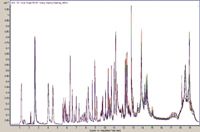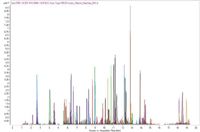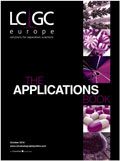Peptide Mapping of a Monoclonal Antibody Using Agilent Poroshell 120
Agilent Technologies Application Note
Susanne C. Moyer, Agilent Technologies Inc., Wilmington, Delaware, USA.
Protein-based pharmaceutical drugs, such as fusion proteins and monoclonal antibodies (mAb), are playing an increasing role in modern therapeutics. Analytical characterization of protein therapeutics is very complex and time consuming. One type of analysis that is undertaken to determine the primary structure of the protein is peptide mapping. In peptide mapping analysis, it is imperative that 100% sequence coverage be achieved and that modifications to the molecule are identified. Typical LC–MS peptide mapping protocols can have LC gradients in excess of 100 min. Obviously, such lengthy run times adversely affect throughput capabilities and methods for reducing these run times while achieving analytical goals are needed. The Agilent Poroshell 120-SB C18 column was used for the LC–MS analysis of a tryptic digest of a monoclonal antibody (mAb) standard to demonstrate a greatly reduced analysis time of 20 min while achieving 100% sequence coverage of both the heavy and the light chains.
Experimental Conditions
A 3.0 × 150 mm Agilent Poroshell 120 SB-C18 column (PN 683975-302) was used with an Agilent 1200 LC and 6520 QTOF for peptide mapping experiments. Mobile phase A: 0.1% formic acid in water and mobile phase B: 0.1% fomic acid in acetonitrile. The flow rate of the column was 0.3 mL/min and the column temperature was maintained at 40 °C. The LC gradient was: 0–3 min 2% B, 3–13 min 2–45% B, 13–15 min 45–65% B, 15–15.1 min 65–90% B, 15.1–17 min 90% B, 17–18 min 90–2% B, stop time 20 min.
Results and Discussion
Complex tryptic digests of mABs employ shallow gradients, often stepped, to separate the many peptide fragments into discreet peaks. Often tryptic maps take 2 h to complete using 2.1 × 250 mm, 5 μm particle-sized columns, significantly affecting laboratory productivity. Sample degradation also may occur between long injection cycles so any reduction in analysis time is welcome.
One way to achieve shorter analysis times is to use Poroshell 120 columns. These columns contain 2.7 μm superficially porous particles that provide almost equivalent efficiency to UHPLC (sub-two micron totally porous) columns. Thus, more efficient Poroshell 120 particles packed in a shorter column length can provide similar chromatographic results to their longer 5 μm predecessors in a fraction of the time.
A tryptic digestion of a standard 10 pmol mAb was injected five times onto a Poroshell 120 column. Total analysis time including gradient re-equilibration was only 20 min. Figure 1 shows the five overlays of the total ion chromatograms (TIC). Good retention time, reproducibility and peak-to-peak resolution indicate a stable instrument, column, mobile phase gradient and re-equilibration, and is the first indicator of a robust method for validation. Also, Poroshell 120 columns have larger frit pores compared to smaller sub-two micron column frits, to resist plugging from 'dirty' or complex samples such as protein hydrolysates.

Figure 1: Fast, low pressure analysis; all 11 peaks on Poroshell 120 are resolved by the time the first peak elutes on the original 5 μm Eclipse plus method.
The faster analysis gained from Poroshell 120 did not compromise the chromatographic map of the mAb. Figure 2 shows the results from Agilent MassHunter Molecular Feature Extractor (MFE). MFE is an algorithm that uses the LC retention time and the QTOF accurate mass to extract unique compounds from the data set. These MFE compound results are then matched back to the heavy chain and light chain protein sequences from the mAb standard. This 20 min Poroshell-120 method resulted in 100% sequence coverage for both the heavy and light chains of the mAb.

Figure 2: Flow rate on Poroshell 120 can be increased to further enhance productivity with minimal impact on resolution and conditional peak capacity (nc).
Conclusion
The Poroshell 120 SB-C18 column can greatly reduce the analysis time of an LC–MS peptide mapping experiment, while achieving high-performance and highly reproducible peptide separations. The combination of highly efficient 2.7 μm superficially porous particles and relatively large pored frits make Poroshell 120 ideal for analysis if complex samples such as mAb digests.
References
1. L.W. Dick Jr et al., J. Chromatogr. B, 877, 230–236 (2009).

Agilent Technologies Inc.
2850 Centerville Road, Wilmington, Delaware 19808, USA
tel. +1 800 227 9770 fax +1 302 633 8901

Removing Double-Stranded RNA Impurities Using Chromatography
April 8th 2025Researchers from Agency for Science, Technology and Research in Singapore recently published a review article exploring how chromatography can be used to remove double-stranded RNA impurities during mRNA therapeutics production.



















